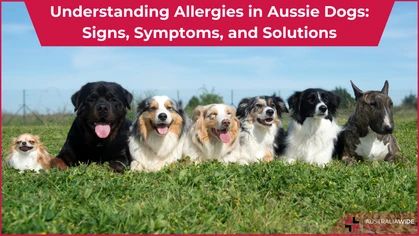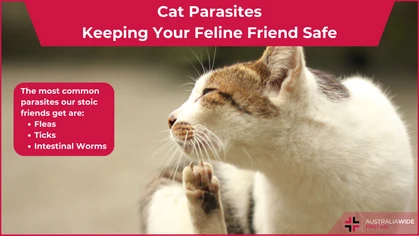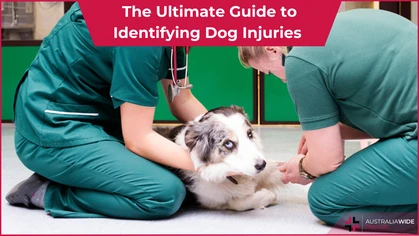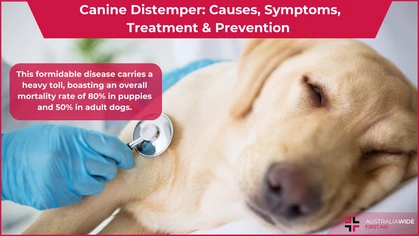First Aid: Wound Care for Dogs

Pets
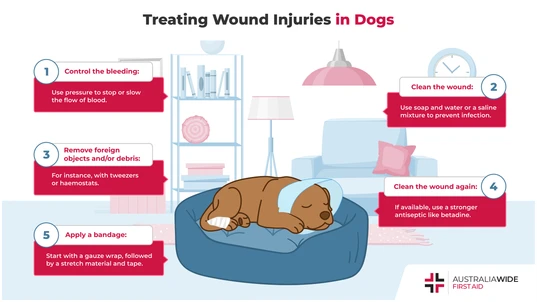
A wound refers to a puncture, abrasion, and/or musculoskeletal injury. Dogs can incur wounds in their natural settings, and from animal encounters. Knowing basic first aid for dogs can help you treat their wounds at home, or stop their condition from deteriorating before professional help arrives.
Wound care refers to therapy and treatment for a puncture, abrasion, and/or musculoskeletal injury. Dogs may incur wounds in natural settings, during animal encounters, from exercise, or by accident at home. A wound injury can be a frightening experience for pet owners, especially for someone without first aid training. Fortunately, wound treatment in dogs is very similar to wound treatment in humans aside from a few minor differences. Educating yourself on basic first aid for your dog can help you treat your pet at home or buy time for you to seek out professional assistance. In this article, we will review the types of wound injuries your dog may have, first aid treatment, and dog-specific approaches to wound care.Assessing Wound Injuries
Your first steps after an injury are to assess the safety situation, then identify the type of injury your dog sustained.Assess for safety:
Are you able to safely access your dog or are there threats that need to be addressed first? Is your dog acting aggressively in response to the trauma? Address any safety concerns before attempting to administer first aid.Identify the Injury:
Assess your dog for signs of injury by observing different parts of their body and their behaviour.- Limbs: assess for limping, clicking sounds, bleeding.
- Heart rate: a dog’s normal heart rate is 80-100 beats per minute. Immediately after an injury, expect their heart rate to increase. However, it should return to normal levels within a few minutes in a calm environment.
- Respiratory rate: a dog’s normal respiratory rate is 10-35 breaths per minute.
- Behaviour: if your dog appears in distress, help to calm him using a calm voice, slow movements, and a blanket.
Evaluate the Injury:
Wound injuries may be in the form of abrasions, open bone fractures, puncture wounds, lacerations, or burns. Monitor the site for bleeding. Venous injuries (injury to a vein) are typically slow, dark red, and possibly oozing. Arterial injuries (injury to an artery) will have bleeding that is strong, bright red, and might be pulsing. Arterial injuries are more dangerous. Check the site for the presence of foreign objects.Provide First Aid: 5-Step Approach
Now that you have brought your dog to a safe space and assessed the injury, it is time to provide first aid using the following 5 steps:- Control the bleeding: Use pressure to stop or slow the flow of blood.
- Clean the wound: Use soap and water or a saline mixture. See the wound cleaning section below for more details.
- Remove foreign objects and/or debris: Use tweezers or hemostats if available.
- Clean the wound again: Use a stronger antiseptic if available. Otherwise use soap and water or saline again.
- Apply a bandage: See the bandaging section below for more details.
Bandaging for Dogs
Apply a non-stick pad (like Telfa pads) to the site of injury Apply padding and pressure over the injury to stop bleeding. Wrap the affected area. If the injury is on a leg or foot, wrap in a figure-8 pattern. If you have a variety of bandaging materials on hand, wrap first with gauze, then with a stretch material, like an ACE wrap, over the top. Apply tape over the bandage to stabilize the wrap. Avoid bandaging too tight as this can restrict blood flow. Note: When wrapping the foot, push the foot into its weight-bearing position so that the wrap is not too tight when the foot returns to its natural standing position.Wound Cleaning for Dogs
Wounds should be properly cleaned as soon as possible to prevent bacterial infection. The first cleaning of the wound should be done with soap and clean water or a saline mixture. DIY Saline mixture: 1 cup of water with ½ tsp of non-iodized salt. Boil for 15 minutes with a lid on the pot. Next, remove debris and any foreign objects, then clean the wound again. It may be appropriate during the second wound cleaning to use a disinfectant such as chlorhexidine or betadine if available. Follow the instructions on the bottle for use. If you have antibiotic ointments, such as Neosporin, apply them to the wound after cleaning.Maintenance
Wound care must be performed as soon as possible after the injury and maintained once or twice a day until healed. For less serious wounds, maintenance wound care may only involve changing the outer bandage when soiled. For more serious wounds, you may need to change the entire bandage once or twice a day and reapply an antibiotic ointment. Seek guidance from a licensed veterinarian for maintenance wound care of more serious wounds or for wounds that are not improving.Recommended Resources
For more information on pet first aid, check out our article library. You may enjoy reading:- First Aid for Pets
- Wound Care for Cats
- Paw Care: First Aid for Dogs
Originally published at
https://www.australiawidefirstaid.com.au/resources/wound-care-for-dogs
as part of the Australia Wide First Aid Articles Library
